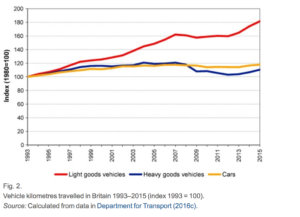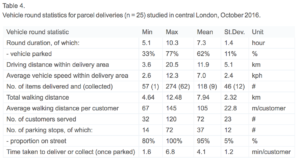Growth in e-commerce has led to increasing use of light goods vehicles for parcel deliveries in urban areas. A new paper by UK researchers provides an insight into the reasons behind this growth and the resulting effort required to meet the exacting parcel services offered by e-retailers which often lead to poor vehicle utilisation in the last-mile operation, as well as the duplication of delivery services in urban centres as competitors fight for business and market share.
London
A case study investigating current parcel delivery operations in central London (UK) identified the scale of the challenge facing the last-mile parcel delivery driver, highlighting the importance of walking which can account for 62% of the total vehicle round time and 40% of the total round distance in the operations studied.
Findings
The researchers highlight other pressures on last-mile operators associated with managing seasonal peaks in demand, reduced lead times between customers placing orders and deliveries being made, meeting tighter delivery time windows, first-time right delivery rates and the need to manage high levels of product returns.
It concludes by describing a range of initiatives that retailers and parcel carriers, sometimes in conjunction with city authorities, can implement to reduce the costs associated with last-mile delivery, without negatively impacting on customer service levels.
The characteristics of these operations are in direct conflict with the urban infrastructure which is being increasingly redesigned in favour of walking, cycling and public transport, reducing the kerbside accessibility for last-mile operations.
The research provides many interesting data and observations about the growing use of light commercial vehicles in London (and a helpful approach for other cities). The data can support development of new dynamic planning software, the implementation of light (and autonomous) electric vehicles and management of loading and unloading zones in cities.
Source: Researchgate
The full paper is available here.


